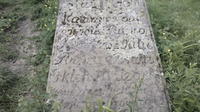Polish Cemetery in Zvenigorodka from Kiev
Kiev, Ukraine
Trip Type: Private Sightseeing Tours
Duration: 10 hours
Polish Cemetery in Zvenigorodka from Kiev. Zvenigorodka is today a town and county seat in the Cherkassy region of the Ukraine, located on the Predeprovsk Hills above the Ghiloi Tikich River (now called the Uman River) in the Bug River Valley. It is seven kilometers from Zvenigorodka Castle and boasts a population of 15,000 as of 2010.
More About This Activity All Private Sightseeing Tours →
Polish Cemetery in Zvenigorodka from Kiev. Zvenigorodka is today a town and county seat in the Cherkassy region of the Ukraine, located on the Predeprovsk Hills above the Ghiloi Tikich River (now called the Uman River) in the Bug River Valley. It is seven kilometers from Zvenigorodka Castle and boasts a population of 15,000 as of 2010.Polish Cemetery in Zvenigorodka from Kiev period of the Second Partition of the Polish–Lithuanian Commonwealth in 1743. Graves of the Polish–Lithuanian heroes who defend Motherland against the Russian Impair's troops. The town appeared during the time of Kievan Russia. For years it was ruled by Poland. It was attacked in 1737, and in 1743 Zvenigorodka castle was stormed and captured. In 1792 the town was placed under Magdeburg rule. After the second partition of Poland in 1793 that part of the Ukraine located on the right bank of the Dnieper River was incorporated into Russia. Russia, a country that did not permit the entrance of Jews suddenly by the partition of Poland found itself with millions of them. Zvenyhorodka became part of the Grand Duchy of Lithuania in the beginning of the 15th century. It passed to theCrown of the Kingdom of Poland in 1569. In 1792, King Stanisław August Poniatowski granted Zwinogródka city rights. It was a royal city of Poland. In the next year it was annexed by Russia after the Second Partition of Poland.The 1793 Second Partition of the Polish–Lithuanian Commonwealth was the second of three partitions (or partial annexations) that ended the existence of the Polish–Lithuanian Commonwealth by 1795. The second partition occurred in the aftermath of the War in Defense of the Constitution and the Targowica Confederation of 1792, and was approved by its territorial beneficiaries, the Russian Empire and the Kingdom of Prussia. The division was ratified by the coerced Polish parliament (Sejm) in 1793 (see the Grodno Sejm) in a short-lived attempt to prevent the inevitable complete annexation of Poland, the Third Partition.
« Go Back

